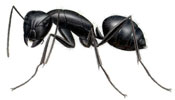Having an insect infestation take control of a home is always stressful, but the many common insect pests of homes differ tremendously in the amount of problems that they create for homeowners. For example, one type of insect pest, and the most common within homes, are nuisance insect pests. These insect pests include most fly species, most ant species, stink bugs, ladybugs, boxelder bugs and many more. While nuisance pests do not pose a disease threat to humans, they often invade homes in such large number that eradicating them is often difficult and may require the services of a professional pest control service. Far more serious than nuisance insect pests are insect pests to structural wood. The four most common insect pests of structural wood in Massachusetts are eastern subterranean termites, carpenter ants, powder post beetles, and less frequently, carpenter bees. Subterranean termites and carpenter ants are, by far, the most significant wood-destroying insect pests in the state, but research has shown that carpenter ant infestation complaints are slowly displacing subterranean termite infestation complaints in Massachusetts and other northeast states.
The termite population in Massachusetts is currently categorized as “moderate to heavy” and the Federal Housing Administration requires homebuyers in the state to provide a termite inspection report before a loan can be issued. Also, many studies have found that termite populations will only increase in Massachusetts in the coming years as a result of warmer temperatures making the northeast environment more hospitable to the insects. Although it cannot be doubted that subterranean termites are a serious problem in Massachusetts, one study revealed that carpenter ants are displacing termites as the most frequent invader of homes in the state. Researchers believe that a few reasons can explain this trend. First of all, many sophisticated and effective termite control measures have been introduced into America during the past several decades, most notably the application of structural and/or termiticide barriers within the soil surrounding homes. Since the soil-dwelling eastern subterranean termite is the only termite species that exists in Massachusetts, these soil barriers have proven sufficient at drastically reducing termite invasions into homes in the state. Unfortunately, carpenter ant control programs are relatively underdeveloped and infestations are notoriously hard to both prevent and control. Second of all, increasing suburbanization into carpenter ant habitats has been blamed on the increase in carpenter ant infestations in new Massachusetts homes. Carpenter ant infestations are best prevented by ensuring that structural wood is not exposed to water or high moisture, as the insects only burrow into damp wood.
Have you ever spotted what you thought was a carpenter ant within an indoor area?

